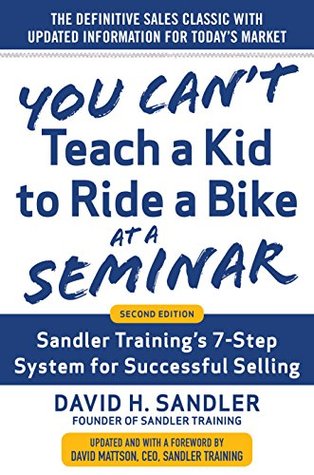More on this book
Kindle Notes & Highlights
Read between
April 21 - May 9, 2017
To succeed in sales, you must observe only five rules: 1. Qualify your prospects. 2. Extract your prospect’s pain. 3. Verify that the prospect has money. 4. Be sure the prospect is a decision maker. 5. Match your service or product to the prospect’s pain.
someone fails to move forward with you on specific, timely, commitment-driven discussions about pain, budget, and decision process, that disqualifies the opportunity.
Step 3. You must discover the decision-making process your prospect uses when deciding to buy or not to buy a product or service.
Your sales presentation has little to do with the features and benefits touted by the marketing department and everything to do with showing your prospect that your product or service can eliminate the pain.
They buy things to help them overcome or avoid pain. All you need to do is show your prospects (see Chapter 14) that your product or service will eliminate their pain. It’s as simple as that.
The Child wants to buy, the Adult makes the decision, and the Parent gives permission to the Child to have what the Adult wants.
selling. In Chapter 1, I told you that if you don’t use a system for selling, you will fall prey to your prospect’s system every time.
Questions allow the prospect to become emotionally involved. People make decisions intellectually, but they buy emotionally.
You say: “Sarah, if you had a magic wand that could produce the ideal solution to your problem, what would it be?”
Let’s say you go the doctor with a sore shoulder. The doctor listens to your complaint, and then does what? Asks questions, of course. In fact, the doctor will ask a series of probing questions, such as: “How long have you been in pain?” “Where does it hurt?” “Is the pain sharp or dull?” “What happens if you move your arm this way, or that way?”
The doctor doesn’t rush in to solve your problem.
Nor does the doctor give you a dissertation about the anatomy of the body. Certainly, at this point, the doctor doesn’t gather up a collection of slides, flipcharts, brochures, and so on, to show you all the different varieties of shoulders in the human race!
So why shouldn’t you, as a sales professional, behave similarly? Why shouldn’t you ask questions? Why shouldn’t you clarify the meaning of words? Why not get all the details before you make a commitment?
People make decisions intellectually, but they buy emotionally.
When you sell, pursue only the pain! All the other emotions aren’t as strong, so ignore them. Cut below the surface, uncover the prospect’s real motivations, and expose the pain.
Remember, people buy emotionally, so they must feel their pain before the sale can be closed successfully. If you move prospects through the selling formula
too quickly, you’re going to lose the sale.
It’s important to ask the question this way because it’s much easier to close a sale if the prospects have discovered their own pain rather than hearing you disclose their pain. People don’t like to admit their pain.
The News Story Approach Get to the heart of your prospect’s decision-making process by asking the following questions. Ask the “What” Qualifier “Jim, what decision-making process do you go through when deciding on a purchase like this one?” Ask the “When” Qualifier “When do you see yourself moving forward with this project, Jim?”
Ask the “How” Qualifier “Assuming that you want to move forward, how is it going to happen? Do I get a purchase order? A check? Or how exactly does that happen?”
Ask the “Who” Qualifier “Jim, who besides you will be involved in the decision-making process?” A key phrase in this qualifier is “who besides you.”
Times change and technologies change, but goal-oriented salespeople who harness the combined power of behavior, attitude, and technique will never go out of style, and the sales profession itself will never go the way of the dinosaur. —DHM


